Komodo
National Park
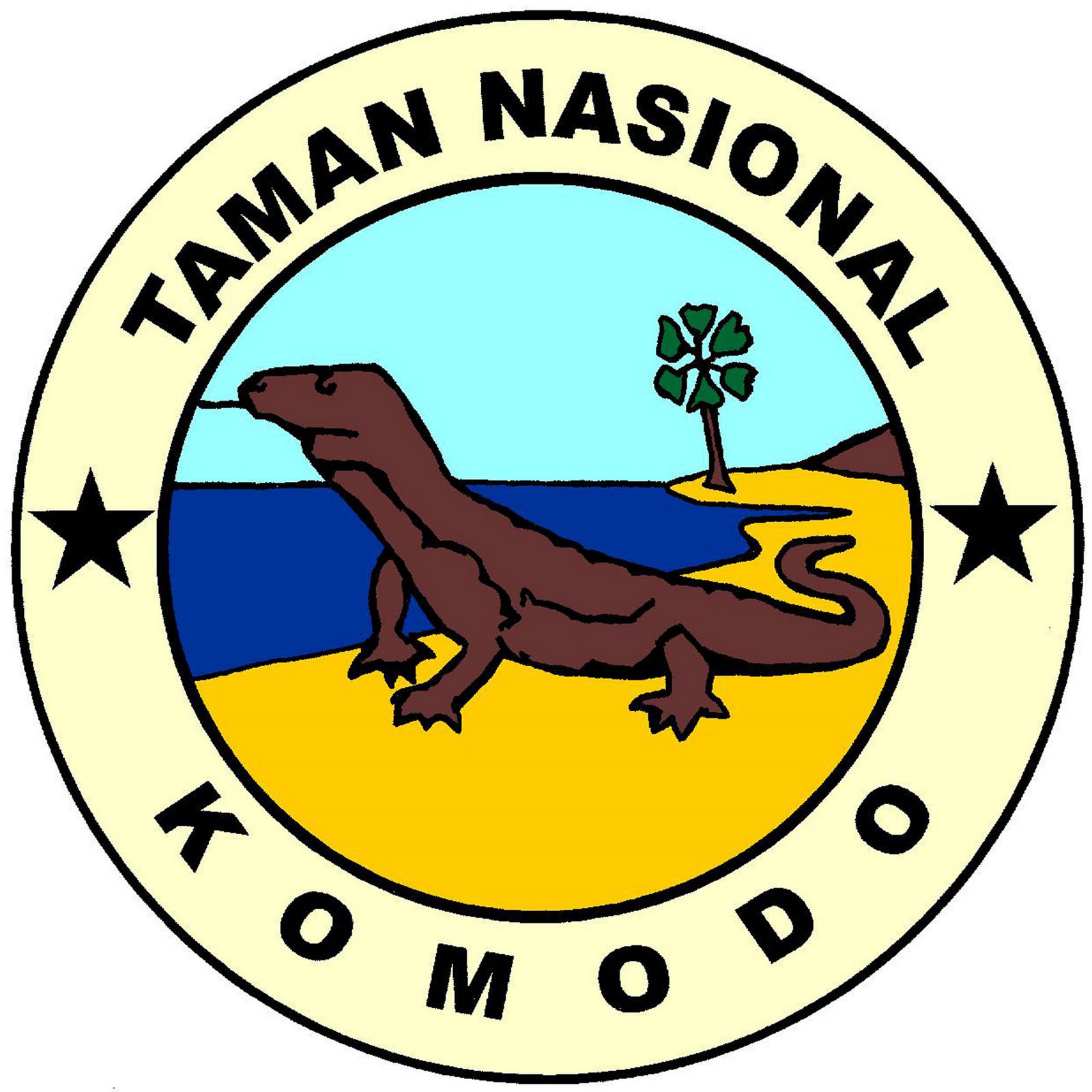 Komodo National Park (Indonesian: Taman Nasional Komodo) is a national park in Indonesia located within the Lesser Sunda Islands in the border region between the provinces of East Nusa Tenggara and West Nusa Tenggara. The park includes the three larger islands Komodo, Padar and Rinca, and 26 smaller ones, with a total area of 1,733 km2 (603 km2 of it land). The national park was founded in 1980 to protect the Komodo dragon, the world’s largest lizard. Later it was dedicated to protecting other species, including marine species. In 1991 the national park was declared a UNESCO World Heritage Site.
Komodo National Park (Indonesian: Taman Nasional Komodo) is a national park in Indonesia located within the Lesser Sunda Islands in the border region between the provinces of East Nusa Tenggara and West Nusa Tenggara. The park includes the three larger islands Komodo, Padar and Rinca, and 26 smaller ones, with a total area of 1,733 km2 (603 km2 of it land). The national park was founded in 1980 to protect the Komodo dragon, the world’s largest lizard. Later it was dedicated to protecting other species, including marine species. In 1991 the national park was declared a UNESCO World Heritage Site.
Komodo National Park has been selected as one of the New7Wonders of Nature. The waters surrounding Komodo island contain rich marine biodiversity. Komodo islands is also a part of the Coral Triangle, which contains some of the richest marine biodiversity on Earth.
The majority of the people in and around the park are fishermen originally from Bima (Sumbawa), Manggarai, South Flores, and South Sulawesi. Those from South Sulawesi are from the Suku Bajau or Bugis ethnic groups. The Suku Bajau were originally nomadic and moved from location to location in the region of Sulawesi, Nusa Tenggara and Maluku, to make their livelihoods. Descendants of the original people of Komodo, the Ata Modo, still live in Komodo, but there are no pure blood people left and their culture and language is slowly being integrated with the recent migrants.
Little is known of the early history of the Komodo islanders. They were subjects of the Sultanate of Bima, although the island’s remoteness from Bima meant its affairs were probably little troubled by the Sultanate other than by occasional demands for tribute.
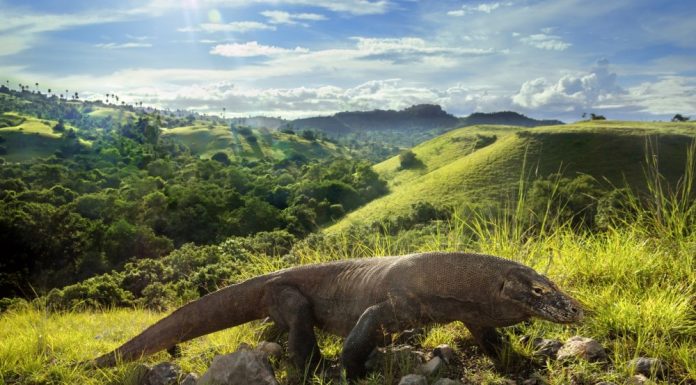 Geography and Climate
Geography and Climate
The park comprises a coastal section of western Flores, the three larger islands of Komodo, Padar and Rinca, 26 smaller islands and the surrounding waters of the Sape Straights. The islands of the national park are of volcanic origin. The terrain is generally rugged, characterized by rounded hills, with altitudes up to 735 m. The climate is one of the driest of Indonesia with annual rainfall between 800mm and 1000mm. Harsh daily temperatures in the dry season from May to October are around 40 °C.
Flora and Fauna
The hot and dry climate of the park, characterized by savannah vegetation, makes it a good habitat for the endemic Komodo dragon (Varanus komodoensis). Their populations are restricted to the islands of Komodo (1,700), Rinca (1,300), Gili Motang (100), Gili Dasami (100), and Flores (c. 2,000), while extinct on Padar.
Cloud forests appear only in few areas above 500 metres but they provide habitat to several endemic flora. Coastal vegetation includes mangrove forest, which generally appear in the sheltered bays of the three larger islands.
 Fringing and patch coral reefs are extensive and best developed on the north-east coast of Komodo. The park is rich in marine life, including whale sharks, ocean sunfish, manta rays, eagle rays, pygmy seahorse, false pipefish, clown frogfish, nudibranchs, blue-ringed octopus, sponges, tunicates, and coral.
Fringing and patch coral reefs are extensive and best developed on the north-east coast of Komodo. The park is rich in marine life, including whale sharks, ocean sunfish, manta rays, eagle rays, pygmy seahorse, false pipefish, clown frogfish, nudibranchs, blue-ringed octopus, sponges, tunicates, and coral.
Varieties of cetaceans inhabit in adjacent waters from smaller sized dolphins to sperm whales and even blue whales. Omura’s whales, one of the least known of rorquals have been confirmed to range waters within the park. Endangered dugongs still live in Komodo areas as well.
The terrestrial fauna is of rather poor diversity in comparison to the marine fauna. The number of terrestrial animal species found in the park is not high, but the area is important from a conservation perspective as some species are endemic. Many of the mammals are Asiatic in origin Including the Timor deer, wild boar, water buffalo, crab eating macaques and civet. Several of the reptiles and birds are Australian in origin. These include the orange-footed scrubfowl, the lesser sulpher crested cockatoo, and the helmeted friarbird.
 The most famous of Komodo National Park’s reptiles is the Komodo dragon (Varanus komodoensis). It is the world’s largest lizard and is among the world’s largest reptiles and can reach 3m or more in length and weigh over 70 kg.
The most famous of Komodo National Park’s reptiles is the Komodo dragon (Varanus komodoensis). It is the world’s largest lizard and is among the world’s largest reptiles and can reach 3m or more in length and weigh over 70 kg.
Twelve terrestrial snake species are found on the island in addition to marine species. Snakes include the Javan spitting cobra (Naja sputatrix), Russell’s viper (Daboia russelii), white-lipped pit viper ( Trimeresurus albolabris), blue lipped sea krait (Laticauda laticaudata), and Timor python (Python timoriensis).
Lizards include nine skink species (Scinidae), geckos (Gekkonidae), limbless lizards (Dibamidae), and the monitor lizards such as the Komodo dragon (Varanidae). Frogs include the Asian bullfrog (Kaloula baleata), the endemic Komodo cross frog (Oreophryne jeffersoniana) and Oreophryne darewskyi. Frogs are typically found at higher, moister altitudes. The saltwater crocodile (Crocodylus porosus) was once present within the park in coastal areas including mangrove swamps but is now extinct within the area.

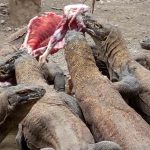
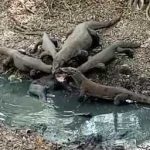

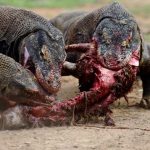
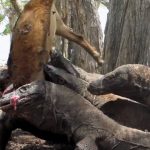
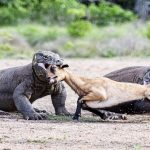

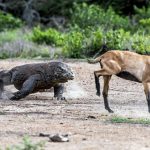
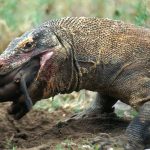
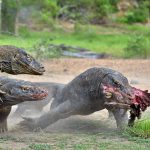
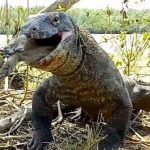
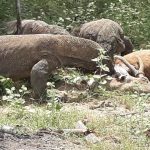
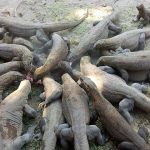
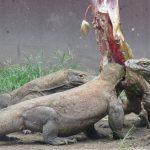












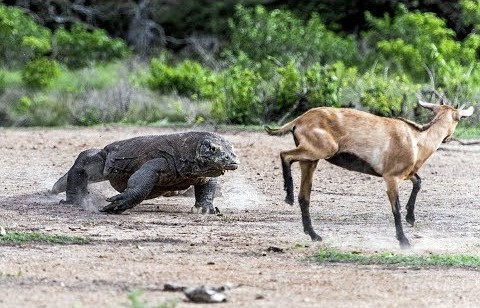 Mammals found within the park include the Timor rusa deer (Cervus timorensis), the main prey of the Komodo dragon, horses (Equus sp.), water buffalo (Bubalus bubalis), wild boar (Sus scrofa vittatus), crab-eating macaque (Macaca fascicularis), Asian palm civet (Paradoxurus hermaphroditus lehmanni), the endemic Rinca rat (Rattus rintjanus), and fruit bats. Domestic mammals on within the park include goats, cats and dogs which are feral.
Mammals found within the park include the Timor rusa deer (Cervus timorensis), the main prey of the Komodo dragon, horses (Equus sp.), water buffalo (Bubalus bubalis), wild boar (Sus scrofa vittatus), crab-eating macaque (Macaca fascicularis), Asian palm civet (Paradoxurus hermaphroditus lehmanni), the endemic Rinca rat (Rattus rintjanus), and fruit bats. Domestic mammals on within the park include goats, cats and dogs which are feral.
One of the main bird species is the orange-footed scrubfowl (Megapodius reinwardti), a ground dwelling bird. In areas of savanna, 27 species were observed. The zebra dove (Geopelia striata) and spotted dove (Spilopelia chinensis) were the most common species.
In mixed tropical deciduous habitat, 28 bird species were observed, and helmeted friarbird (Philemon buceroides), green imperial pigeon (Ducula aenea), and lemon-bellied white-eye (Zosterops chloris) were the most common. Other birds include vibrantly coloured species such as green junglefowl (Gallus varius), great-billed parrot (Tanygnathus megalorynchos), and the critically endangered lesser sulpher crested cockatoo (Cacatua sulphurea). Two eagle species are found in the park, the white-bellied sea eagle and the extremely rare Flores hawk-eagle which is present on Rinca and Flores and reported but unconfirmed on Komodo Island.
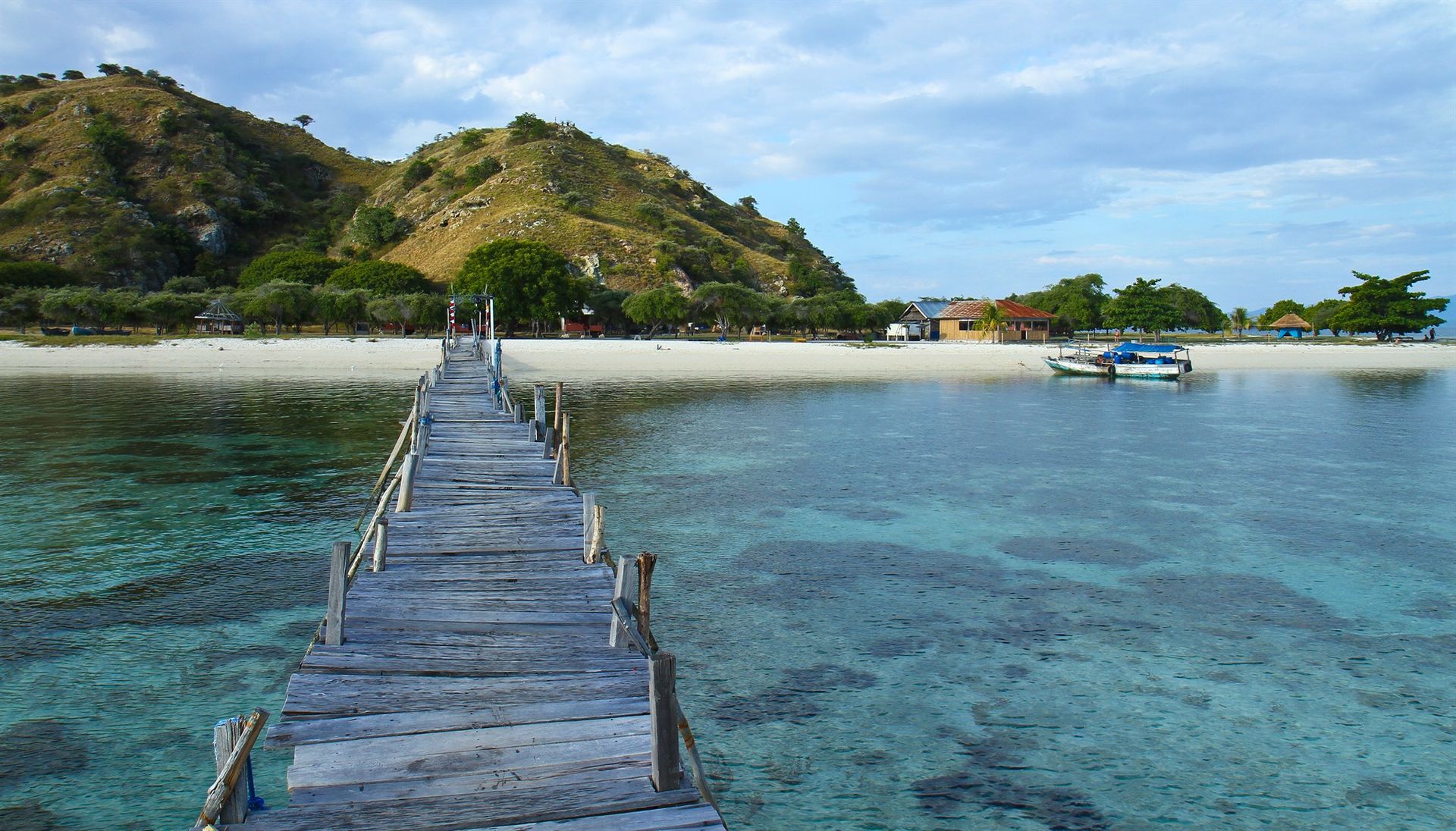 Conservation
Conservation
The island of Padar and part of Rinca were established as nature reserves in 1938. Komodo Island was declared a nature reserve in 1965, and in January 1977 as a biosphere reserve under the UNESCO Man and Biosphere Programme. The three islands were declared a national park in 1980, which was later extended to include the surrounding marine area and a section of Flores in 1984. In 1991 the national park was declared a UNESCO World Heritage Site.
For a period after 1995 the national park authority was supported by The Nature Conservancy (TNC), an American environmental organization. A management plan was co-authored with TNC and implemented in 2000 to address problem of increasing resource exploitation, both marine and terrestrial. The plan was supported by the World Bank but faced objections from some local people and local NGOs who argued that they had not been consulted by the plan and would not share in the benefits.
Most pressure on marine resources originates from fishing communities and commercial enterprises from outside the park. However, regulations and restrictions on resource use impact mostly on park residents, who have few options to make a living but rely on what the park has to offer. The provision of alternative livelihoods is part of the overall management strategy, but communities within the park are yet to benefit from appropriate measures addressing their needs.
 Human habitation
Human habitation
There are presently almost 4,000 people living within the park spread out over four settlements (Komodo, Rinca, Kerora, and Papagaran). All villages existed before 1980 when the area was declared a national park. In 1928 there were only 30 people living in Komodo Village (known locally as Kampung Komodo), and approximately 250 people on Rinca Island in 1930. The population increased rapidly, and by 1999, there were 281 families numbering 1,169 people on Komodo Island.
Komodo Village has had the highest population within the park, mostly due to migration by people from Sape, Manggarai, Madura, and South Sulawesi. The number of buildings in Komodo Village has increased rapidly from 30 houses in 1958, to 194 houses in 1994, and 270 houses in 2000. Papagaran Village is similar in size, with 258 families totaling 1,078 people.
At the 2010 Census, Komodo Village had 1,508 inhabitants and Papagaran Village had 1,262 inhabitants. As of 1999, Rinca’s population was 835, and Kerora’s population was 185 people. The total population currently living in the park is 3,267 people with 16,816 people live in the area immediately surrounding the park.
 Tourism
Tourism
Scuba diving is popular because of the park’s high marine biodiversity. The development of, largely marine-based, ecotourism is the main strategy to make the park self-financing and generate sufficient revenue through entrance fees and tourism licenses to cover operational and managerial costs. To this end, a joint venture between TNC and a tourism operator were granted a tourism concession, that also entails extensive park management rights.
This concession has generated an ongoing controversy. The joint venture has been accused of making decisions behind closed doors, and many people in and around Komodo claim that they haven’t been consulted regarding decisions that ultimately affect their lives.
Komodo Island and Rinca were once part of Flores and they are separated from the large Island of Sumbawa to the West by the Sape Strait. The ocean in the Strait drops hundreds of meters.
The Pacific Ocean to the north and the Indian Ocean to the south are actually at different heights, so the flow of currents from the Pacific to the Indian during tidal exchanges makes the currents among the strongest in the world. In the (relatively) shallow waters along the east coast of Komodo towards Labaun Bajo, these currents can be extremely dangerous with inexperienced guides.
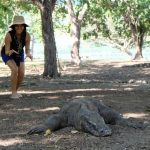
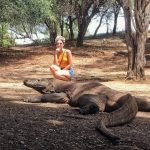
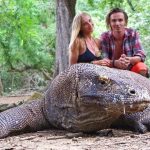
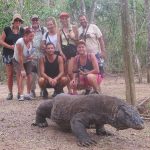

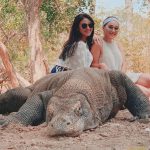
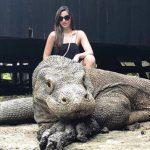
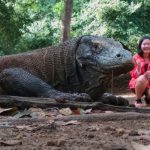
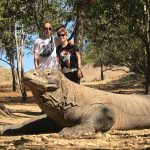
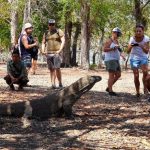
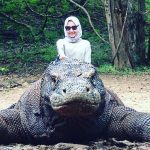
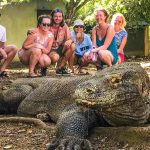
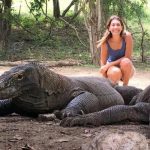
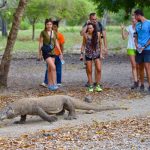












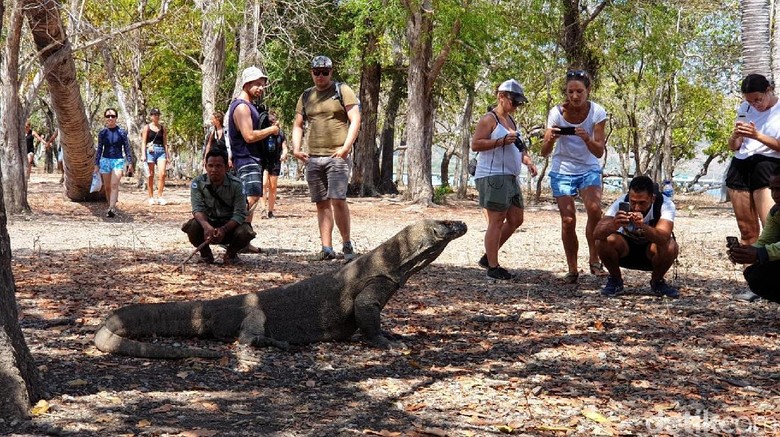 The number of visitors to the park increased from 36,000 in 2009 to 45,000 in 2010. Most of the visitors were foreign tourists as the high transport cost to this remote location is less affordable for local visitors. The park can accommodate up to 60,000 visitors a year according to the local tourism agency.
The number of visitors to the park increased from 36,000 in 2009 to 45,000 in 2010. Most of the visitors were foreign tourists as the high transport cost to this remote location is less affordable for local visitors. The park can accommodate up to 60,000 visitors a year according to the local tourism agency.
Several types of boat tours run through the national park including upscale scuba liveaboards, short daily snorkel trips and 4 day, 3 night ‘tourist boats’ between Lombok and Flores. The tourist boats run very frequently, but have uncertain safety records. In an August 2014 incident one of these tourist boats sank, and 2 tourists were lost. Strong currents and waves separated the stranded passengers and crew who were floating at sea in lifevests.
How to Reach Komodo
While most visitors enter Komodo National Park (KNP) through the gateway cities of Labuan Bajo in the west of Flores or Bima in eastern Sumbawa, the departure point for your trip is actually Denpasar, Bali.
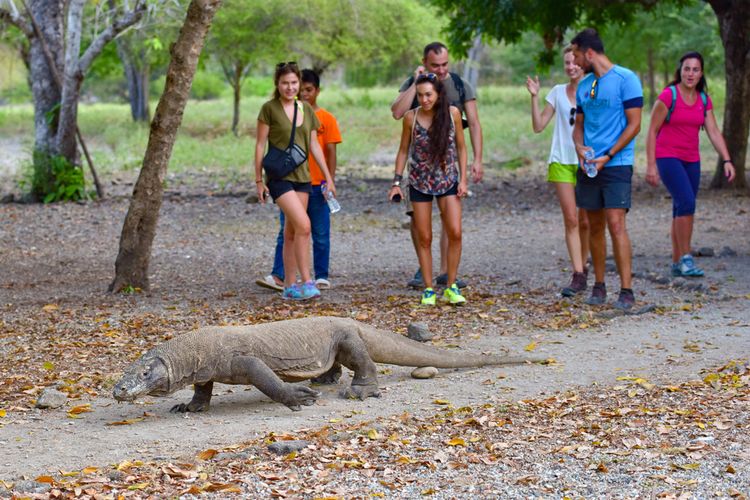 By Air
By Air
The airport nearest to Komodo Island is Komodo Airport which is situated in the town of Labuan Bajo in Flores. Frans Seda Airport (also called Maumere Airport) serving the town of Maumere in Flores is also near Komodo. You can fly from Jakarta or Bali to these places and then proceed from there to Komodo by ferry. Bima Airport (Sultan Muhammad Salahudin Airport) in the island of Sumbawa also has flights to Bali and ferry service to Komodo Island though these ferry services are not very regular.
The planes that operate in the Bali-Labuan Bajo route are typically small and are filled easily. So it is safer to book your seats sufficiently in advance.
By Road
There is no way you can travel to Komodo completely by road but there are overland bus trips from Bali to Komodo which include three ferry crossings, namely to Lombok from Bali, to Sumbawa from Lombok, and to Labuan Bajo from Sumbawa.
By Boat
The last portion of the journey, from Labuan Bajo (or Maumere) to Komodo can only be by ferry. The boat journey from Labuan Bajo to Komodo takes about 3 to 4 hours. There is no port as such in Komodo Island. Travellers have to disembark from the boat and shift to smaller vessels that will take them to the island.
You can stay in a resort in Labuan Bajo and explore Komodo dive sites on a liveaboard. Alternatively, you can get a boat in Labuan Bajo and go on your own cruise to explore the park and also snorkel to your satisfaction. There are many travel agencies which will arrange such cruises for you.
